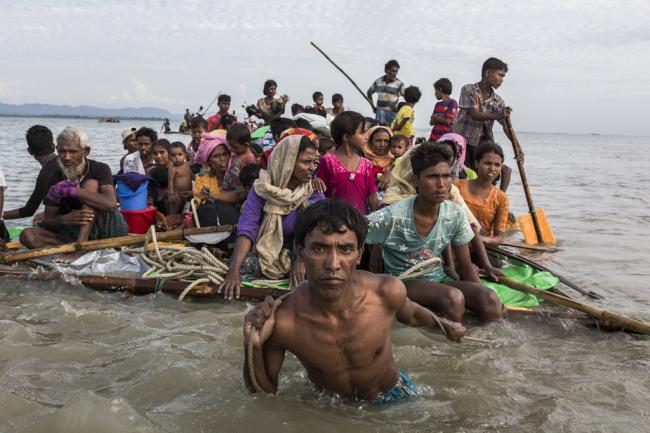
Desperate Rohingya refugees use home-made rafts to get to Bangladesh – UN
New York, Nov 18(Just Earth News): Over the past 10 days, dozens of makeshift rafts carrying more than a thousand people have floated into Bangladesh, proof that Rohingya refugees are resorting to increasingly desperate means to flee to Myanmar, the United Nations refugee agency said on Friday.
“Unable to pay for the crossing, refugees are building rafts from whatever material they can get their hands on – mostly bamboo poles and empty jerry cans tied together with rope and covered with plastic sheets,” William Spindler, spokesperson for the Office of the UN High Commissioner for Refugees (UNHCR), told reporters at the regular press briefing in Geneva.
“Using paddles made of bamboo and plastic debris some of these rafts made it to Shahporir Dwip in Bangladesh, a journey of about four hours,” he added, pointing out that the Naf river estuary between the two countries is about three kilometres wide at this point.
According to Spindler, more than 100 Rohingya refugees are known to have drowned in shipwrecks and boat incidents since the start of the crisis on 25 August, and recent arrivals said they had been waiting for more than a month in desperate conditions on Myanmar' shores with food and water running low.
“An estimated 620,000 Rohingya refugees have fled to Bangladesh since 25 August,” the UNHCR spokesperson explained. “The Kutupalong Extension site alone, which was set up soon after the influx began, is now highly congested sheltering some 335,000 new arrivals – more than half of the influx so far.”
Citing UN Habitat data that Dhaka's population density is 44,500 people per square kilometre, UNHCR said 13 out of 20 blocks in the Kutupalong Extension area are more densely populated than parts of the Bangladesh capital city, with an area known as Block CC sheltering more than 95,000 people per square kilometre.
“Despite concerted efforts to deliver more aid and services, the overcrowding and difficult living conditions in the camps and makeshift sites increase health, sanitation and fire risks as well as violence and trafficking,” stressed Spindler.
Additional land and more space for shelters and infrastructure are needed urgently to provide life-saving services and aid, including water points, latrines and spaces for women and girls.
As high population density also escalates risks, particularly for sexual and gender based violence (SGBV), UNHCR is engaging all segments of the refugee communities to raise awareness.
“Together with our partners, we are working to put in place referral pathways for women, survivors of SGBV, as well as safe spaces for women and girls,” said Spindler.
Solar-powered healthcare
Meanwhile, the UN International Organization for (IOM) is using solar energy to power its health posts in Kutupalong and Balukali makeshift settlements – now home to an estimated 440,000 Rohingya refugees.
“As the demand for our healthcare services increases, solar-powered lighting means we can provide round the clock emergency consultations and medicine distributions,” said Mariam Abdelkerim-Spijkerman, the IOM Emergency Health Officer in Cox's Bazar.
Prior to the latest refugee influx, in close collaboration with the World Health Organization (WHO) and the Bangladeshi Ministry of Health and Family Welfare, IOM had been coordinating aid work in the health sector.
As people continue to flood into the settlements, pressure on the health sector has steadily risen.
“The health needs of the refugees are immense - providing 24-hour lighting helps save lives,” explained Abdelkerim-Spijkerman.
Photo: UNHCR/Andrew McConnell
Source: www.justearthnews.com
Support Our Journalism
We cannot do without you.. your contribution supports unbiased journalism
IBNS is not driven by any ism- not wokeism, not racism, not skewed secularism, not hyper right-wing or left liberal ideals, nor by any hardline religious beliefs or hyper nationalism. We want to serve you good old objective news, as they are. We do not judge or preach. We let people decide for themselves. We only try to present factual and well-sourced news.







